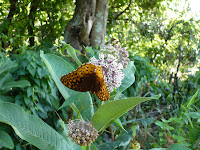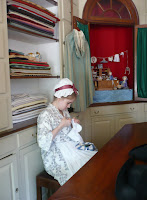The official title of the 4 separate Civil War battlefields near Fredericksburg, VA, is Fredericksburg and Spotsylvania County Battlefields Memorial National Military Park. Each battlefield has a driving tour, and a complete tour of the the whole thing covers over 70 miles. After a hot and humid afternoon of running errands, we only visited one: Fredericksburg Battlefield Visitors Center in town. Just walked, didn't drive.
 We saw the movie at the Visitors Center, then went outside for a tour of the battlefield. The intern who led our tour is a college kid--I'd say she's a Valley Girl, but she's from Chicago. She’s perky and enthusiastic, uses big wild gestures, which makes her fun to watch. A little exhausting, but fun.
We saw the movie at the Visitors Center, then went outside for a tour of the battlefield. The intern who led our tour is a college kid--I'd say she's a Valley Girl, but she's from Chicago. She’s perky and enthusiastic, uses big wild gestures, which makes her fun to watch. A little exhausting, but fun.I don’t know how much Civil War history you remember. (I can remember who won, a few battles, a few generals.) Therefore, a lot of this history stuff seems brand-new to me. If I bore you, feel free to skip to the pictures.
Poor Fredericksburg was midway between the Confederate capital of Richmond and the Union capital of Washington. It’s on the banks of the Rappahannock River, a natural defensive position. There were 3 major campaigns near there, and 4 battles: 2 at Fredericksburg, Chancellorsville, and Wilderness & Spotsylvania Court House. In all there were over 105,000 casualties! More than 80% of the 15,000 Union soldiers buried at the Fredericksburg Natl Cemetery are unidentified…
Union General Ambrose Burnside (his weird whiskers prompted the term sideburns) seems to have been particularly inept; some consider him one of the worst commanders of the Civil War. Fredericksburg was one of his fiascos. After his troops finally crossed the river to occupy then sack the town, he kept pushing waves of soldiers across bare fields. The Confederates had the advantage of high ground at Marye’s Heights (pronounced “Marie’s”), and were entrenched behind the walls of the Sunken Road. One of the Confederate soldiers said that they didn't have to worry about missing, and often hit two at a time. In 8 hours, Burnside's strategy lost 8,000 soldiers—1,000 died men every hour.
 |
| Confederate position on Sunken Road |
 |
| Brompton House (Confederate Headquarters) |
 |
| Innis House |
Fredericksburg was a triumph for Robert E. Lee & Stonewall Jackson, and a miserable defeat for the Union. The park website has some pretty good info on the battle if you want to find out more. NPS History of Fredericksburg Battle
 |
| Monument to "Angel of Maryes Heights" who carried water to wounded on both sides |

















































